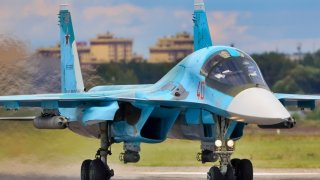Ukrainian Drones Destroyed One of Three Beriev Be-200s
Russia's ongoing conflict in Ukraine has led to the loss of numerous aircraft, including a Beriev Be-200 from its fleet, which suffered significant damage in a recent attack on Yeysk Air Base. The Be-200, a versatile jet-propelled flying boat, is crucial for multiple roles including firefighting, search and rescue, and military transport.
Summary: Russia's ongoing conflict in Ukraine has led to the loss of numerous aircraft, including a Beriev Be-200 from its fleet, which suffered significant damage in a recent attack on Yeysk Air Base. The Be-200, a versatile jet-propelled flying boat, is crucial for multiple roles including firefighting, search and rescue, and military transport. Only three such aircraft were in service, making this loss impactful, particularly for the Russian Navy’s logistical capabilities. The damaged aircraft, evident from satellite imagery, underscores the vulnerability of Russian military assets and the ongoing attrition affecting its operational readiness in the region.
Recent Attack Damages Rare Russian Be-200 Aircraft Amid Ukraine Conflic
Russia has lost hundreds of aircraft in its nearly twenty-six-month-long war in Ukraine, and that has included nearly a dozen Sukhoi Su-34 (NATO reporting name Fullback) fighters this year. However, when Kyiv’s forces launched attacks on several key Russian air bases earlier this month, they succeeded in destroying—or at least seriously damaging—one of just three Beriev Be-200 aircraft.
The Be-200 is unique in that it’s a jet-propelled flying boat, able to take off and land on both land and sea, making it a versatile aircraft. The three Beriev Be-200s formed a major component of the Russian military’s air cargo fleet and are difficult to easily replace.
According to a report from David Axe of Forbes, satellite images from Planet Labs showed significant damage to one of the 30-ton twin-jet Be-200s, and it is unclear if the aircraft can be returned to service. The photos appeared to show a parked Be-200 missing a wing panel, while there was evidence of a fuel leak.
However, Axe also was quick to suggest that while the Yeysk Air Base—where the Be-200 came under the recent attack—is also home to an A-50 radar early warning aircraft, and there is some speculation the transport could have been a commercially-owned aircraft. Beriev has one or two on its rolls for tests.
If it was a Russian Navy Be-200, it could further reduce Russia’s ability to resupply its depleted navy’s Black Sea Fleet.
The Beriev Be-200 Altair in the crosshairs
Development of the Be-200 began in the late 1980s, but it wasn’t until September 1998 that the aircraft took its maiden flight. It was presented in the West at the 1999 Paris Air Show. It was initially marketed for use in firefighting, search and rescue, maritime patrol, and cargo and passenger transportation.
In a firefighting capacity, the Altair can carry up to 3,200 gallons (12,000 liters) of water, and two Be-200 aircraft were used to fight the devastating forest fires in Greece in the summer of 2007, and again in December of that same year.
In its transport configuration, the Be-200 can carry as many as seventy-two passengers. The aircraft has a range of 3,300 km and a service ceiling of 8,000 meters. Powered by two, over-the-fuselage, pylon-mounted Progress D-436TP engines—a maritime corrosion-resistant version of the D-436 three-shaft turbofan engine—it can reach a maximum speed of 680km/h.
A total of nineteen Be-2000s have been built, while three were ordered by the Russian Ministry of Defense in 2018, with the first one delivered in 2020. It was adopted to replace the Russian Navy’s aging fleet of Beriev Be-12 turboprop-powered amphibious aircraft, which entered service in 1963.
Author Experience and Expertise: Peter Suciu
Peter Suciu is a Michigan-based writer. He has contributed to more than four dozen magazines, newspapers, and websites with over 3,200 published pieces over a twenty-year career in journalism. He regularly writes about military hardware, firearms history, cybersecurity, politics, and international affairs. Peter is also a Contributing Writer for Forbes and Clearance Jobs. You can follow him on Twitter: @PeterSuciu. You can email the author: [email protected].
Note: Image is of a Russian Su-34 Fullback.

